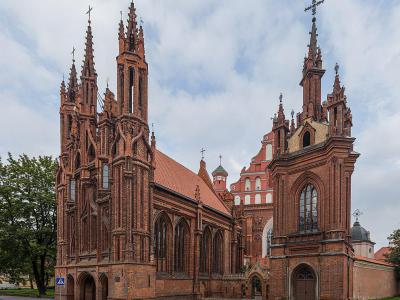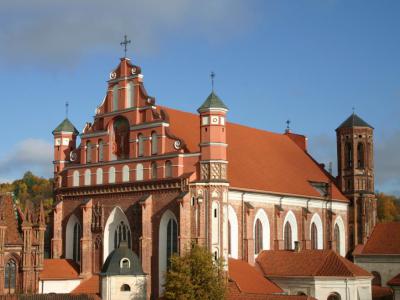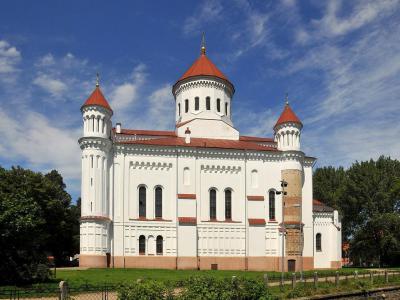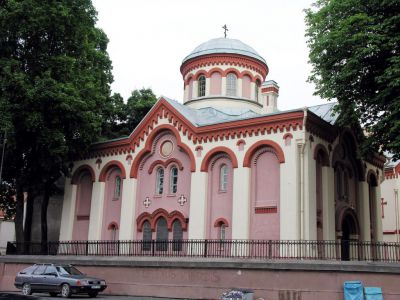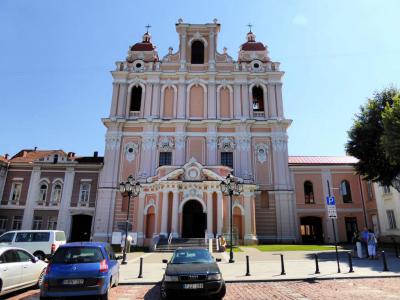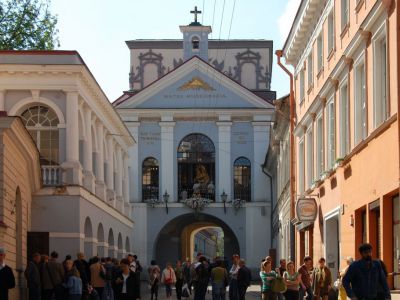Historical Churches Tour (Self Guided), Vilnius
As the seat of the Roman Catholic Archdiocese and the Russian Orthodox Diocese of Lithuania, Vilnius boasts a wealth of gorgeous churches featuring diverse architectural styles – Gothic, Baroque, to mention but a few. Many of the local churches are historical, having witnessed centuries of events and become iconic landmarks of the Lithuanian capital.
One of the most famous temples in Vilnius is Saint Anne's Church. Known for its intricate Gothic architecture, this building is a masterpiece of medieval craftsmanship. The elaborate red-brick facade has earned it a reputation as a true architectural gem.
The nearby Bernardine Church is another noteworthy religious site. This Baroque-style edifice features ornate decorations and a striking interior, making it a popular destination for both tourists and locals.
The Cathedral of the Theotokos is a symbol of Lithuania's Orthodox Christian heritage. This 14th-century cathedral houses the crypts of many Lithuanian dignitaries and is a place of historical significance.
Also reflecting the Orthodox Christian faith's presence in Vilnius are the Church of Saint Paraskeva, whose colorful interior and eye-catching facade make it a captivating place to explore, and the Holy Spirit Orthodox Church, whose stunning artwork inside is a testament to the city's diverse religious landscape.
Another architectural marvel, known for its Baroque style and elegant interior, is Saint Casimir's Church – dedicated to the late 15th-century Prince Casimir canonized as a saint.
The Gate of Dawn and the Chapel of Our Lady of the Gate of Dawn hold immense cultural and religious significance. The Chapel houses a revered icon of the Virgin Mary, which draws pilgrims from far and wide.
Visiting these places of worship in Vilnius provides a unique opportunity to explore the city's rich spiritual traditions. So, if you're planning a trip to Vilnius, make sure to include these historical churches in your itinerary. They are not only architectural marvels but also windows into the city's fascinating history and religious diversity.
One of the most famous temples in Vilnius is Saint Anne's Church. Known for its intricate Gothic architecture, this building is a masterpiece of medieval craftsmanship. The elaborate red-brick facade has earned it a reputation as a true architectural gem.
The nearby Bernardine Church is another noteworthy religious site. This Baroque-style edifice features ornate decorations and a striking interior, making it a popular destination for both tourists and locals.
The Cathedral of the Theotokos is a symbol of Lithuania's Orthodox Christian heritage. This 14th-century cathedral houses the crypts of many Lithuanian dignitaries and is a place of historical significance.
Also reflecting the Orthodox Christian faith's presence in Vilnius are the Church of Saint Paraskeva, whose colorful interior and eye-catching facade make it a captivating place to explore, and the Holy Spirit Orthodox Church, whose stunning artwork inside is a testament to the city's diverse religious landscape.
Another architectural marvel, known for its Baroque style and elegant interior, is Saint Casimir's Church – dedicated to the late 15th-century Prince Casimir canonized as a saint.
The Gate of Dawn and the Chapel of Our Lady of the Gate of Dawn hold immense cultural and religious significance. The Chapel houses a revered icon of the Virgin Mary, which draws pilgrims from far and wide.
Visiting these places of worship in Vilnius provides a unique opportunity to explore the city's rich spiritual traditions. So, if you're planning a trip to Vilnius, make sure to include these historical churches in your itinerary. They are not only architectural marvels but also windows into the city's fascinating history and religious diversity.
How it works: Download the app "GPSmyCity: Walks in 1K+ Cities" from Apple App Store or Google Play Store to your mobile phone or tablet. The app turns your mobile device into a personal tour guide and its built-in GPS navigation functions guide you from one tour stop to next. The app works offline, so no data plan is needed when traveling abroad.
Historical Churches Tour Map
Guide Name: Historical Churches Tour
Guide Location: Lithuania » Vilnius (See other walking tours in Vilnius)
Guide Type: Self-guided Walking Tour (Sightseeing)
# of Attractions: 7
Tour Duration: 1 Hour(s)
Travel Distance: 1.4 Km or 0.9 Miles
Author: emily
Sight(s) Featured in This Guide:
Guide Location: Lithuania » Vilnius (See other walking tours in Vilnius)
Guide Type: Self-guided Walking Tour (Sightseeing)
# of Attractions: 7
Tour Duration: 1 Hour(s)
Travel Distance: 1.4 Km or 0.9 Miles
Author: emily
Sight(s) Featured in This Guide:
- St. Anne's Church
- Bernardine Church
- Cathedral of the Theotokos
- Orthodox Church of St. Paraskeva
- St. Casimir's Church
- Holy Spirit Orthodox Church
- Gate of Dawn and the Chapel
1) St. Anne's Church (must see)
St. Anne’s Church is a well-known landmark in Vilnius, located on the left bank of the Vilnia River. This Roman Catholic church is admired for its impressive Flamboyant and Brick Gothic architecture and is one of the important monuments that contributed to Vilnius Old Town being included on the UNESCO World Heritage List.
The site’s first church, a wooden structure, was built in 1394 for German Catholics and other foreign visitors. While a legend connects it to Anna, Grand Duchess of Lithuania, who was a known benefactor, historical evidence suggests the church was not originally built specifically for her. After the wooden church was destroyed by fire in 1419, King of Poland and Grand Duke of Lithuania Alexander I Jagiellon commissioned the construction of the current brick church between 1495 and 1500. Its exterior has remained virtually unchanged since that time.
According to local legend, Emperor Napoleon was so captivated by the church during his 1812 campaign that he wished he could carry it back to Paris “in the palm of his hand.” The story has become part of Vilnius’ folklore, reflecting the deep admiration this elegant structure continues to inspire.
The church’s facade is a masterpiece of balance and rhythm, combining pointed Gothic arches with rectangular frames and vertical lines that create a sense of graceful movement. Built from 33 different types of clay bricks, the red-brick surface shimmers beautifully in the sunlight. Inside, the simpler Baroque interior, redesigned in 1749, contrasts with the richly detailed exterior, offering a calm and contemplative space for worship.
A neo-Gothic bell tower, added in the 1870s, complements the church’s architecture and completes this harmonious ensemble. Today, St. Anne’s Church remains one of the finest symbols of Vilnius—an enduring blend of legend, artistry, and faith that continues to enchant visitors, just as it once captivated Napoleon himself.
The site’s first church, a wooden structure, was built in 1394 for German Catholics and other foreign visitors. While a legend connects it to Anna, Grand Duchess of Lithuania, who was a known benefactor, historical evidence suggests the church was not originally built specifically for her. After the wooden church was destroyed by fire in 1419, King of Poland and Grand Duke of Lithuania Alexander I Jagiellon commissioned the construction of the current brick church between 1495 and 1500. Its exterior has remained virtually unchanged since that time.
According to local legend, Emperor Napoleon was so captivated by the church during his 1812 campaign that he wished he could carry it back to Paris “in the palm of his hand.” The story has become part of Vilnius’ folklore, reflecting the deep admiration this elegant structure continues to inspire.
The church’s facade is a masterpiece of balance and rhythm, combining pointed Gothic arches with rectangular frames and vertical lines that create a sense of graceful movement. Built from 33 different types of clay bricks, the red-brick surface shimmers beautifully in the sunlight. Inside, the simpler Baroque interior, redesigned in 1749, contrasts with the richly detailed exterior, offering a calm and contemplative space for worship.
A neo-Gothic bell tower, added in the 1870s, complements the church’s architecture and completes this harmonious ensemble. Today, St. Anne’s Church remains one of the finest symbols of Vilnius—an enduring blend of legend, artistry, and faith that continues to enchant visitors, just as it once captivated Napoleon himself.
2) Bernardine Church
The Church of Saint Francis and Saint Bernard, also known as the Bernardine Church, is a Roman Catholic church located right next to Saint Anne’s Church. Dedicated to Saints Francis of Assisi and Bernardino of Siena, it stands as one of Lithuania’s most important examples of Gothic architecture.
Following their arrival in Vilnius, the Bernardine monks first built a wooden church in the second half of the 15th century, followed by a brick structure at the end of the century. In the early 16th century, the church was reconstructed and integrated into Vilnius’ defensive walls. Later, Renaissance and Baroque elements were added during the 17th and 18th centuries, giving the church its rich architectural character.
The Bernardine Church is notably larger than the nearby Saint Anne’s Church—a reflection of a local legend that the monks’ sermons were so compelling that they drew large crowds, necessitating a bigger building.
During the Soviet era, the church was closed and repurposed as an art institute, before reopening for worship in 1994. The church houses early 16th-century mural paintings, unique for combining Renaissance composition and subject matter with Gothic stylistics, making them a rare artistic treasure in the world.
Following their arrival in Vilnius, the Bernardine monks first built a wooden church in the second half of the 15th century, followed by a brick structure at the end of the century. In the early 16th century, the church was reconstructed and integrated into Vilnius’ defensive walls. Later, Renaissance and Baroque elements were added during the 17th and 18th centuries, giving the church its rich architectural character.
The Bernardine Church is notably larger than the nearby Saint Anne’s Church—a reflection of a local legend that the monks’ sermons were so compelling that they drew large crowds, necessitating a bigger building.
During the Soviet era, the church was closed and repurposed as an art institute, before reopening for worship in 1994. The church houses early 16th-century mural paintings, unique for combining Renaissance composition and subject matter with Gothic stylistics, making them a rare artistic treasure in the world.
3) Cathedral of the Theotokos
The Cathedral of the Theotokos in Vilnius is a significant Orthodox Christian church, serving as the episcopal seat of the Eastern Orthodox Christian Metropolitan of Vilnius and all Lithuania. This ancient church has a rich history that dates back to the 14th century, even before the Christianization of Lithuania. It was a significant spiritual center that served the growing Christian population of the Grand Duchy of Lithuania.
The cathedral was built in 1346 during the reign of Grand Duke Algirdas for his Orthodox second wife, Uliana of Tver. It is one of the oldest buildings in Vilnius and has witnessed many important events in Lithuania's history. The cathedral was the site of the marriage between Grand Duke Aleksandras of Lithuania and Helena of Moscow, daughter of Ivan III, which took place in 1495 in the presence of Saint Macarius. Helena was later buried there in 1513.
The cathedral was abandoned in 1748 after a major fire and was used for various other purposes. It was reconstructed in the Baroque style in 1785, but it was once again destroyed during the Kościuszko Uprising by the Russian army. Despite being damaged during World War II, the cathedral was restored in 1948, although renovations were not completed until 1957.
Today, the Cathedral of the Theotokos belongs to the Russian Orthodox Church and continues to serve as an important spiritual center for Orthodox Christians. Its services are attended mostly by ethnic Russian and Belarusian residents of Vilnius. The cathedral is a testament to the rich history of Lithuania and the enduring legacy of Orthodoxy in the region.
The cathedral was built in 1346 during the reign of Grand Duke Algirdas for his Orthodox second wife, Uliana of Tver. It is one of the oldest buildings in Vilnius and has witnessed many important events in Lithuania's history. The cathedral was the site of the marriage between Grand Duke Aleksandras of Lithuania and Helena of Moscow, daughter of Ivan III, which took place in 1495 in the presence of Saint Macarius. Helena was later buried there in 1513.
The cathedral was abandoned in 1748 after a major fire and was used for various other purposes. It was reconstructed in the Baroque style in 1785, but it was once again destroyed during the Kościuszko Uprising by the Russian army. Despite being damaged during World War II, the cathedral was restored in 1948, although renovations were not completed until 1957.
Today, the Cathedral of the Theotokos belongs to the Russian Orthodox Church and continues to serve as an important spiritual center for Orthodox Christians. Its services are attended mostly by ethnic Russian and Belarusian residents of Vilnius. The cathedral is a testament to the rich history of Lithuania and the enduring legacy of Orthodoxy in the region.
4) Orthodox Church of St. Paraskeva
The Orthodox Church of Saint Paraskeva in Vilnius, Lithuania, is a significant landmark and an essential part of the country's religious history. It is the oldest Eastern Orthodox church in Lithuania and is one of only two fully Lithuanian-language parishes of the Orthodox Church in the country.
The first Orthodox church of Saint Paraskeva was built in 1346 at the request of Grand Duke Algirdas's first wife, Maria Yaroslavna of Vitebsk. This church was constructed on the site of a temple to the pagan god, Ragutis. Unfortunately, this church was destroyed by fire in 1557, and it was later rebuilt only to burn down again in 1611. The church was given to the local Eastern Catholics, but in 1655, it was returned to the Orthodox Church and renovated.
During the Great Northern War, in 1705, the church was visited by the Russian tsar Peter the Great, who prayed there for military victory. During the same service, Abram Petrovich Gannibal was baptized, with the tsar serving as the godfather. Three years later, the victorious tsar decided to grant some of the conquered Swedish flags to Saint Paraskeva's church.
In 1748, the building was again destroyed by fire and rebuilt in 1795. However, it stood closed during the following forty years, slowly falling into decline. In 1864, on the orders of the Russian local government, it was rebuilt and enlarged in Neo-Byzantine style by Nikolay Chagin.
The church suffered severe damage during World War II, but it was later renovated. However, the Stalinist government didn't allow the Russian Orthodox Church to start holding its services there. Initially, a Museum of Atheism was to be opened there, but in the end, the church was turned into a gallery of Lithuanian folk art. The church was only given back to the Orthodox Church in 1990 and reconsecrated by Metropolitan Chrysostom the following year. Since then, it has been an auxiliary church of the Cathedral of the Theotokos.
The first Orthodox church of Saint Paraskeva was built in 1346 at the request of Grand Duke Algirdas's first wife, Maria Yaroslavna of Vitebsk. This church was constructed on the site of a temple to the pagan god, Ragutis. Unfortunately, this church was destroyed by fire in 1557, and it was later rebuilt only to burn down again in 1611. The church was given to the local Eastern Catholics, but in 1655, it was returned to the Orthodox Church and renovated.
During the Great Northern War, in 1705, the church was visited by the Russian tsar Peter the Great, who prayed there for military victory. During the same service, Abram Petrovich Gannibal was baptized, with the tsar serving as the godfather. Three years later, the victorious tsar decided to grant some of the conquered Swedish flags to Saint Paraskeva's church.
In 1748, the building was again destroyed by fire and rebuilt in 1795. However, it stood closed during the following forty years, slowly falling into decline. In 1864, on the orders of the Russian local government, it was rebuilt and enlarged in Neo-Byzantine style by Nikolay Chagin.
The church suffered severe damage during World War II, but it was later renovated. However, the Stalinist government didn't allow the Russian Orthodox Church to start holding its services there. Initially, a Museum of Atheism was to be opened there, but in the end, the church was turned into a gallery of Lithuanian folk art. The church was only given back to the Orthodox Church in 1990 and reconsecrated by Metropolitan Chrysostom the following year. Since then, it has been an auxiliary church of the Cathedral of the Theotokos.
5) St. Casimir's Church
The Church of Saint Casimir in Vilnius is a remarkable example of Baroque architecture, and it holds great cultural and historical significance for the people of Lithuania. The church was built in the early 17th century by the Jesuits, with funding from prominent nobles and Chancellor Lew Sapieha, as a tribute to Saint Casimir, a holy prince who is revered as the patron of Lithuania. The church's design was inspired by the Church of Jesus in Rome, and it features a stepped lantern cupola with a crown that is unique to the region.
Over the centuries, the Church of Saint Casimir has undergone various transformations, including periods of occupation and damage during wars. In the 18th century, architect Thomas Zebrowski oversaw a reconstruction of the church, which resulted in the addition of the impressive cupola. During the Soviet era, the church was closed down and converted into a Museum of Atheism, and it suffered significant damage. However, in 1991, the church was reconsecrated and returned to the Catholic community.
Today, the Church of Saint Casimir continues to hold regular services in Lithuanian and Russian, and it is also renowned for its excellent acoustics and organ concerts featuring internationally renowned musicians. The church's interior boasts three late Baroque artificial marble altars, with paintings by Antanas Kmieliauskas depicting scenes from the life of Saint Casimir and other saints.
Overall, the Church of Saint Casimir is a significant religious and cultural landmark in Vilnius, and it represents an important piece of Lithuania's history and heritage. Its rich architectural and artistic features, as well as its connection to Saint Casimir, make it a must-visit destination for tourists and locals alike.
Over the centuries, the Church of Saint Casimir has undergone various transformations, including periods of occupation and damage during wars. In the 18th century, architect Thomas Zebrowski oversaw a reconstruction of the church, which resulted in the addition of the impressive cupola. During the Soviet era, the church was closed down and converted into a Museum of Atheism, and it suffered significant damage. However, in 1991, the church was reconsecrated and returned to the Catholic community.
Today, the Church of Saint Casimir continues to hold regular services in Lithuanian and Russian, and it is also renowned for its excellent acoustics and organ concerts featuring internationally renowned musicians. The church's interior boasts three late Baroque artificial marble altars, with paintings by Antanas Kmieliauskas depicting scenes from the life of Saint Casimir and other saints.
Overall, the Church of Saint Casimir is a significant religious and cultural landmark in Vilnius, and it represents an important piece of Lithuania's history and heritage. Its rich architectural and artistic features, as well as its connection to Saint Casimir, make it a must-visit destination for tourists and locals alike.
6) Holy Spirit Orthodox Church
The Orthodox Church of the Holy Spirit in Vilnius is a stunning architectural monument that dominates the skyline of Old Town. The current church was built in the late baroque style in 1749-1753, on the site of a wooden church and convent that had been erected in 1638. The church's interior features details in the Rococo style, including deep blue and green decor and simulated marble sculptures.
In the 19th century, during the Russian Empire's occupation of Vilnius, Byzantine Revival elements were added to the church, but its essentially Baroque form was preserved. The Orthodox Church of the Holy Spirit's interior also features frescoes, an Iconostasis, and a dome that enhance its magnificence.
One of the most remarkable aspects of the Orthodox Church of the Holy Spirit is its collection of religious artifacts, including a remarkable crucifix that appears to come to life when the light shines on it. The original painting of the Divine Mercy is enshrined above the altar, and Pope John Paul II visited the shrine and prayed before the sacred image in 1993.
The church's crypt contains the remains of Saints Anthony, John, and Eustathios, and a tradition of the church is to cloak them in black during Lent, in white at Christmas, and in red on other major religious holidays.
Overall, the Orthodox Church of the Holy Spirit is a must-see destination for anyone visiting Vilnius, and its stunning architecture and rich collection of religious artifacts make it an important cultural and historical landmark.
In the 19th century, during the Russian Empire's occupation of Vilnius, Byzantine Revival elements were added to the church, but its essentially Baroque form was preserved. The Orthodox Church of the Holy Spirit's interior also features frescoes, an Iconostasis, and a dome that enhance its magnificence.
One of the most remarkable aspects of the Orthodox Church of the Holy Spirit is its collection of religious artifacts, including a remarkable crucifix that appears to come to life when the light shines on it. The original painting of the Divine Mercy is enshrined above the altar, and Pope John Paul II visited the shrine and prayed before the sacred image in 1993.
The church's crypt contains the remains of Saints Anthony, John, and Eustathios, and a tradition of the church is to cloak them in black during Lent, in white at Christmas, and in red on other major religious holidays.
Overall, the Orthodox Church of the Holy Spirit is a must-see destination for anyone visiting Vilnius, and its stunning architecture and rich collection of religious artifacts make it an important cultural and historical landmark.
Sight description based on Wikipedia.
7) Gate of Dawn and the Chapel (must see)
The Gate of Dawn is a city gate in Vilnius, and one of its most important religious, historical and cultural monuments. It is a major site of Catholic pilgrimage in Lithuania.
The Gate of Dawn was built between 1503 and 1522 as a part of defensive fortifications for the city of Vilnius, the capital of the Grand Duchy of Lithuania. Of the nine city gates, only the Gate of Dawn remains, while the others were destroyed by the order of the government at the end of the 18th century.
In the 16th century city gates often contained religious artifacts intended to guard the city from attacks and to bless travelers. The Chapel in the Gate of Dawn contains an icon of The Blessed Virgin Mary Mother of Mercy, said to have miraculous powers. For centuries the picture has been one of the symbols of the city and an object of veneration for both Roman Catholic and Orthodox inhabitants.
The Gate of Dawn was built between 1503 and 1522 as a part of defensive fortifications for the city of Vilnius, the capital of the Grand Duchy of Lithuania. Of the nine city gates, only the Gate of Dawn remains, while the others were destroyed by the order of the government at the end of the 18th century.
In the 16th century city gates often contained religious artifacts intended to guard the city from attacks and to bless travelers. The Chapel in the Gate of Dawn contains an icon of The Blessed Virgin Mary Mother of Mercy, said to have miraculous powers. For centuries the picture has been one of the symbols of the city and an object of veneration for both Roman Catholic and Orthodox inhabitants.
Sight description based on Wikipedia.
Walking Tours in Vilnius, Lithuania
Create Your Own Walk in Vilnius
Creating your own self-guided walk in Vilnius is easy and fun. Choose the city attractions that you want to see and a walk route map will be created just for you. You can even set your hotel as the start point of the walk.
Užupis District Walking Tour
A tiny isolated area and a former suburb, which now forms part of the Old Town of Vilnius, the Uzupis district is often compared, for its bohemian and laissez-faire atmosphere, to Montmartre of Paris and Freetown Christiania of Copenhagen. Similarly to the latter, in 1997, the district declared itself an independent republic; the tongue-in-cheek constitution of the self-proclaimed “republic”,... view more
Tour Duration: 1 Hour(s)
Travel Distance: 1.2 Km or 0.7 Miles
Tour Duration: 1 Hour(s)
Travel Distance: 1.2 Km or 0.7 Miles
Vilnius Old Town Walking Tour
Legend has it that Grand Duke Gediminas dreamed of an iron wolf howling on a hill, inspiring him to found a city that would grow into today’s Vilnius. Centuries later, in 1812, when Napoleon passed through Vilnius during his Russian campaign, he reportedly described the city as “a pearl of the north, full of charm and surprises.”
Vilnius, the capital of Lithuania, is one of Eastern... view more
Tour Duration: 2 Hour(s)
Travel Distance: 4.5 Km or 2.8 Miles
Vilnius, the capital of Lithuania, is one of Eastern... view more
Tour Duration: 2 Hour(s)
Travel Distance: 4.5 Km or 2.8 Miles
The Most Popular Cities
/ view all



